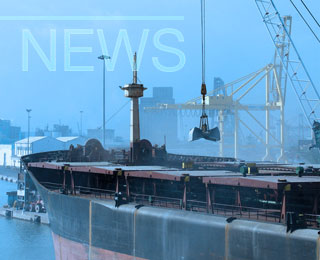As the year comes to a close, it is worth reflecting on a few statistics from the past twelve months since the market highs achieved in May and June, time charter averages for the four main bulk sectors have lost between 91% and 96% of their value. Capes have suffered the most and now stand at 4% of their June peak (against 5%, 7% and 9% for Panamax, Supramax and Handysize) - reports Barry Rogliano, shipbrokers, Paris. The seizure of the credit markets in the autumn burst the asset bubble and we have been in a period of deflation ever since.
Underlying trade figures demonstrate why: from June to the last recorded month of October global steel production volumes dropped 15% to 100Mt, while China’s output fell nearly a quarter to 36Mt. Commodity prices have come under pressure and this week thermal coal exporter Xstrata Plc settled its contracts with Japanese utilities for 2009 at US$80 per ton, compared to US$125 per ton last year.
Amidst the gloom we can find a few positive elements and, with the exception of the Handysize sector (whose index was only launched in 2006), all three bulk sectors are now trading above their historic lows again.
Amid slack demand and contract cancellations, prices of new buildings are expected to continue their downward trend. This prediction was given by Clarksons at a latest report, where it is indicated that a significant drop in newbuilding prices should be expected for 2009, in fact such a fall is “inevitable”. This should happen, in order to generate newbuilding demand. “The yards can look forward to a very difficult year in which they can expect to spend more time addressing their clients’ problems than actually selling ships! It is at least some comfort to the yards in an otherwise gloomy environment that they can also expect to see their cost bases deflating as steel, equipment and labour costs all moderate so, they may well be able to protect their margins in the short term even if prices fall significantly” shipbroker Clarksons reported.
Looking back in 2008, anyone involved in the shipping business can assert that it has been a year of mixed emotions. The first half of the year was a buoyant one, with high freight rates and a newbuilding market that was defying gravity in terms of pricing. According to Clarksons however, “the strength of prices disguised the looming problem that volume was thin and, although the yards were enjoying very high prices, demand was insufficient to replenish or extend their orderbooks as buyers baulked at ever higher prices. Moving into 2009, Clarksons predicts that it too is equally likely to have a split personality, with the market likely to still be feeling rather fragile for the first half of the year, before hopefully emerging “from under the duvet in the 2nd half and showing some signs of life”.
In percentage terms it would appear the Panamax market saw a hefty rally in late December with the four time charters closing 30% up at US$4609/day, while the BPI was up 135 points at 575. There was a rumour of a one-year fixture on an LME type at around the US$12,750/day mark and the market seemed more buoyant, with a tighter tonnage supply in both basins. However the real situation is that there is an increase in activity prior to
the Christmas break, and we still have yet to see a change in the underlying fundamentals.
Supramax and Handysize, were under pressure this week mainly due to a lack of activity and cargoes. The Supramax time charterer average lost US$380 to close the week at US$4745/ day. The USG-Cont route suffered particularly by losing US$1524/day and it is now standing at US$7319, due to a lack of any business. The Baltic-Continent- Mediterranean area was very quiet as well and a good number of tonnage is now starting to stack up. In the Pacific, cargo activity such as grain, nickel ore and mineral sands out of Aussie and Indonesia helped the market to stay marginally above the US$4000/day level. Chinese ore imports helped the India-China route stay above US$10,000/day.
In the Handysize sector, the time charterer average lost US$121 to finish up at US$4284/day. The Atlantic basin was particularly under pressure due to the lack of cargoes, while in the Pacific the market rose slightly to finish close to US$4000/ day.
In the sale and purchase sectors, last week one observed the traditional pre-Xmas ‘slowdown’ in activity, which together with the current state of the freight market, resulted in deals involving only older tonnage. The NJ Goulandris Panamax ‘Lamyra’ (65,000 dwt, built 1983 in Japan) fetched a price in the region of US$3m from undisclosed buyers, while the Brave Maritime-owned ‘Lancelot’ (62,000 dwt, built 1982 in Japan) has been reported sold for a similar US$3m basis delivery in the UAE.
Several 1980s-built Handysizes were also reported sold: the ‘Swiftsure’ (33,000 dwt, built 1980 in Japan) went for US$2.5m to Chinese buyers, while the ‘Kavo Alexandros II’ (27,000 dwt, built 1986 in Japan) fetched US$4.5m. Finally the ‘Fonarun Naree’ (23,000 dwt, built 1984 in Japan) was sold for US$3.15m to Vietnamese buyers - conlcuded Rogliano spokesmen.
Published under Cement News

